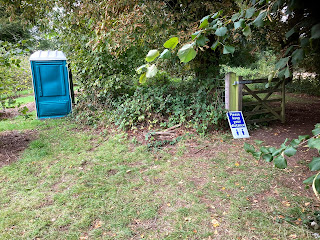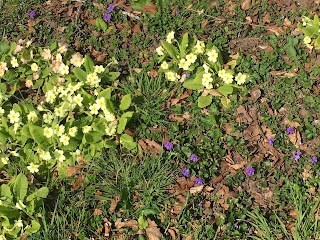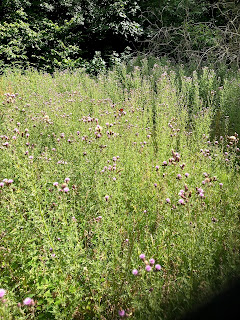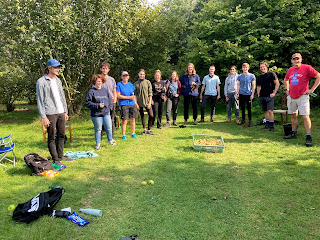My last post was in February 2020 and I ended it by noting that the quantity of little red flowers augured well for a good harvest. In the event the harvest proved to be a fairly average one; not disappointing but not as huge as in 2019. Read on!
Conditions back in February when the flowers were visible were not at all bad for pollination. While there were many rainy days there were also days of calm weather and gentle winds to carry the pollen from the catkin to the flower and that was ideal for pollination.

This year John W who has looked after, pruned, wanded and mown the plat since the start of restoration in 2011/12, finally retired and has moved north to Herefordshire; he is much missed, not least for his knowledge of cobnuts going back years and also for his love of a good argument about subjects unrelated to nuts and which we could never agree on. Before leaving he completed the wanding on the main block and I took the decision to omit top pruning for this year. It would be an experiment to see whether top-pruning in alternate years might be sufficient.
For the young bloc it was the usual routine, Tony did the wanding using our own brush cutter and I with a little help from others did the top-pruning, completed by the end of February or early March. Then 'lockdown' happened and the prunings, usually collected by students from Hadlow College were still lying around. Luckily my neighbours with three young children were glad of the opportunity to get out there in the fresh air. They spent several afternoons collecting the prunings, having bonfires and generally letting off steam after a morning of home-schooling. Thank you to them!
Sales of pea-sticks and bean poles flourished in April, as people turned to their gardens during the lockdown.
 |
| The best of the prunings are kept and made into bundles |
April and May, were those months of glorious spring which kept many of us sane and happy. The flowers on the plat were abundant as usual, primroses, violets, bugle, with carpets of bluebells in the woods bordering the plat.
 |
| Horse chestnut in blossom |
 |
| Twayblade beginning to show its spike |
As the summer arrived, in the hidden 'secret' corner below the plat, thistles and nettles were irresistible for crowds of butterflies. Along with the Meadow Browns and Gatekeepers, numerous Peacock Butterflies and some gorgeous Silver-washed Fritillaries could be found feasting on the nectar in the warm sunshine.
In April I had bought myself an electric bicycle and cycled regularly to the plat to enjoy the peace and calm, not to mention the quiet skies.
 Most other growers that I know reported the same and it wasn't until mid August that I was fortunate to come across someone who would patrol the area and reduce the numbers to some extent. By that stage much damage had been done and perhaps a quarter of the crop on the young bloc and around the edges of the main bloc was lost. The plan for next year is to get on top of the problem a whole lot earlier.
Most other growers that I know reported the same and it wasn't until mid August that I was fortunate to come across someone who would patrol the area and reduce the numbers to some extent. By that stage much damage had been done and perhaps a quarter of the crop on the young bloc and around the edges of the main bloc was lost. The plan for next year is to get on top of the problem a whole lot earlier. It is never easy to judge when will be the right week to start harvesting. In this pandemic year preparations for those two weeks included the necessary convenience, reminders for distancing and daily temperature checks on arrival. I was keen to spare no effort to make things safe.
It is never easy to judge when will be the right week to start harvesting. In this pandemic year preparations for those two weeks included the necessary convenience, reminders for distancing and daily temperature checks on arrival. I was keen to spare no effort to make things safe.
Fortunately we got the dates right. The first weekend of September produced splendid weather for the Volunteer Weekend when a good start was made and a picnic lunch was enjoyed by all, distanced appropriately. Distanced picking wasn't difficult given how the trees are spaced at intervals and pickers worked in pairs or family groups.
After that relatively relaxed volunteer weekend the big push came on the Monday when seventeen pickers arriving to work 8.30 to 4.30 on a paid basis. It had been a worry to know whether enough 'home-grown' pickers could be signed up but, thanks to Charlie's website (www.foodandforest.co.uk), and to publicity on the Plaxtol Village Facebook page, it turned out well and with a good mix of ages. Apart from one couple who departed after the first day, the pickers soon formed into a cohesive team, working in pairs and keeping up the pace. The plan was for two pairs to start at the bottom of a row and another two to work their way down from the top. Meeting in the middle by lunch break was a good target, especially with Charlie urging, encouraging and cheering everyone on.
Amongst the team were students waiting to go up or to return to university while others were tempted in this pandemic year by the idea of a week's work out of doors in the sunshine in beautiful natural surroundings, and were not daunted by the physical nature of the work. Some came from the local area, others from as far afield as Dorset and Yorkshire. Picking nuts is certainly preferable to other back-breaking agricultural work such as harvesting lettuces - at least you stay upright on your feet.

















No comments:
Post a Comment